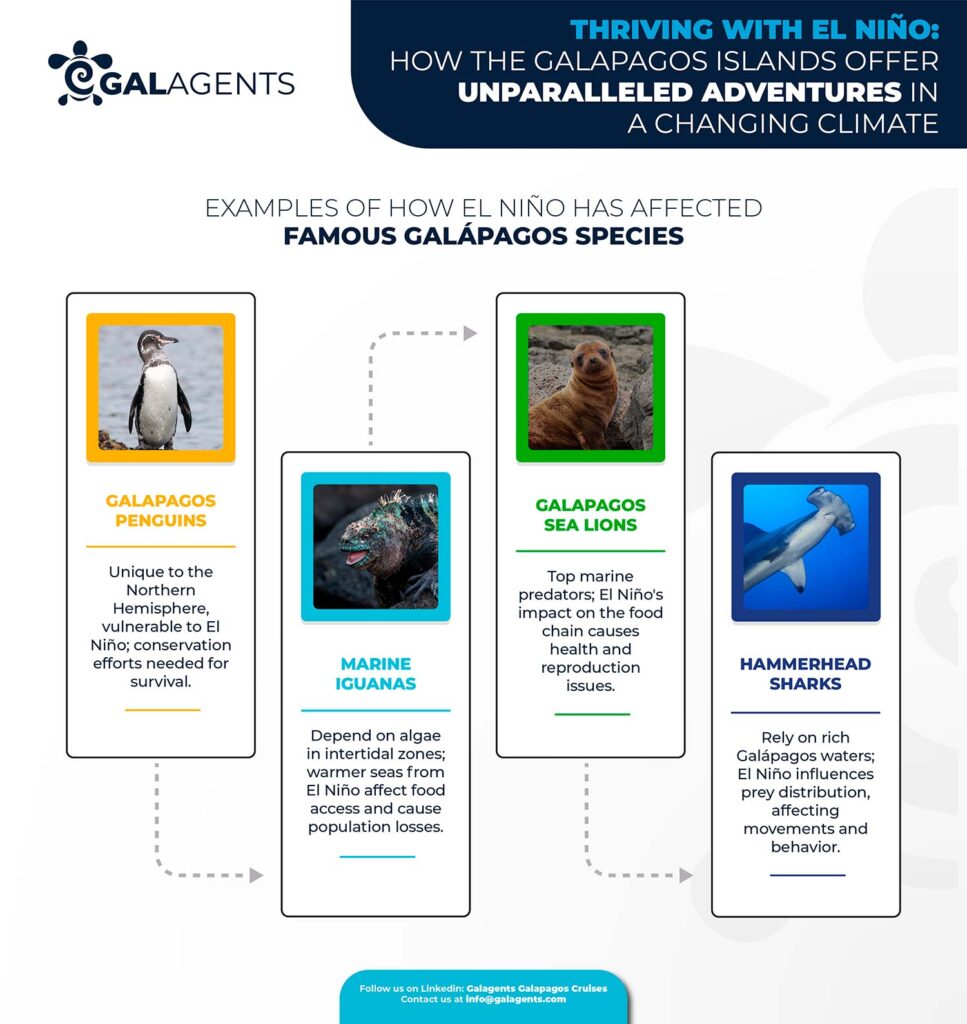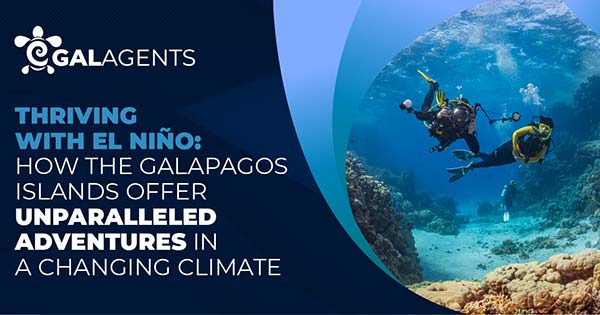Discover how El Niño affects the Galápagos’ unique ecosystems. Experience how the islands and their people survive El Niño with expert guidance and a deep understanding of the region’s natural processes. Witness marine life’s incredible adaptability, dive in unmatched waters, and explore nature’s adaptable land ecosystems. As experts, we offer you to join us on an exciting voyage through the breathtaking Galápagos Islands, where you’ll learn to appreciate life’s delicate balance and nature’s astonishing adaptability.
Learning About El Niño and How It Affects the Galápagos Ecosystem
El Niño is a climatic phenomenon that happens naturally and is caused by the interplay of the ocean and atmosphere in the tropical Pacific. The marine habitats surrounding the Galápagos Islands may suffer significant effects due to their exceptionally warm sea surface temperatures. Warm water can flow eastward into the Galápagos during an El Niño event because the trade winds that generally carry warm water to the western Pacific decrease. This warm water intrusion alters the islands’ typical cold-water upwelling, which is nutrient-rich and supports various marine animals.
Consequences for Marine Life El Niño on the Galápagos Islands may have beneficial and harmful impacts on the marine life there.
On the one hand, the warmer seas could promote the expansion of some species, such as corals and algae. On the other hand, the disturbance of the nutrient-rich upwelling may harm the food chain and reduce the numbers of various fish, seabirds, and marine animals. As different species struggle to adapt to the shifting conditions, this disruption may have cascading effects on the ecosystem as a whole.
For instance, a fall in plankton numbers due to lessened upwelling can result in less food being available for animals that feed on filters, including krill and tiny fish. As a result, larger predators that depend on these smaller species for food, such as tuna, sharks, sea lions, and seabirds, may affect their ability to survive and reproduce.
El Niño’s Effects on Diving Activities
While the El Niño phenomenon can alter diving conditions near the Galápagos Islands, it also provides divers looking for unmatched experiences in the archipelago with special opportunities. The distribution and behavior of marine organisms may change due to warmer oceans, which may surprise and thrill divers eager to explore the diverse undersea environment.
Divers visiting the Galápagos during El Niño occurrences can observe the extraordinary adaptation of the region’s marine life, even if the shifting weather conditions might occasionally impact underwater visibility. Divers are encouraged to recognize the adaptability and diversity of the marine organisms that live in these seas by the changing ecology, and they may even see uncommon or rare species that are prospering in the warmer climate.
Due to these changes, it is crucial for tour companies and divers to keep a close eye on the condition of the ecosystem and modify their activities to have the least possible negative effects on the ecology. Divers may continue to take in the beauty of the Galápagos Islands while developing a greater knowledge and respect for this constantly changing aquatic paradise by embracing the special difficulties and possibilities El Niño brings.

Examples of How El Niño Has Affected Famous Galápagos Species
Let’s look at a few instances involving some of the Galápagos Islands’ most well-known species to demonstrate better how El Niño affects the archipelago:
- Penguins of the Galapagos: The Galápagos penguin is the only species of penguin located in the Northern Hemisphere, and it has explicitly evolved to adapt to the changing climate of the islands. However, decreasing the food supply might result in diminished breeding success and potentially mass extinction occurrences during the El Niño periods. Therefore, conservation initiatives are essential to ensure this endangered species’ long-term survival, including habitat restoration and predator control.
- Marine Iguanas: These unusual reptiles eat mainly algae found in the intertidal zone. The location and amount of algae may shift during El Niño episodes due to the warmer seas, affecting the iguanas’ access to food. This occasionally brings mass hunger and population losses.
- Galápagos Sea Lions: Due to their position as top predators in the marine ecology, sea lions are especially susceptible to changes in the food chain brought on by El Niño occurrences. Reduced body conditions, lower birth rates, and higher mortality rates among sea lions can result from declining fish populations.
- Hammerhead sharks: The scalloped hammerhead sharks congregating in the Galápagos Islands are well-known, and these sharks depend on the islands’ rich waters to sustain their vast schools. The distribution and quantity of hammerhead prey species can be affected by variations in water temperature and nutrient availability during El Niño occurrences, which may result in changes in the sharks’ movements and behavior.
Despite El Niño, the Galapagos offer unparalleled naturalist and diving tourism. The archipelago’s ecosystems adapt to changing climates.
El Niño may diminish shark numbers but increase focus on other marine species that thrive in warmer oceans. Tropical fish and corals grow here, providing divers with a different viewpoint.
Promote island ecosystems to adapt to naturalist tourism. El Niño brings vibrant foliage and flowers for travelers to enjoy. Wildlife lovers can see the Galapagos’ unique plants and creatures adapt to the changing climate.
These weather events teach travelers. El Niño and climate change affect Galapagos habitats, and expert-guided tours and seminars teach travelers about conservation and sustainable tourism.
In conclusion, El Niño threatens Galapagos ecosystems and naturalist and diving tourism, but it also shows the islands’ amazing resiliency. Thus, accepting El Niño’s changes and emphasizing the positives can help the Galapagos attract and educate tourists.

